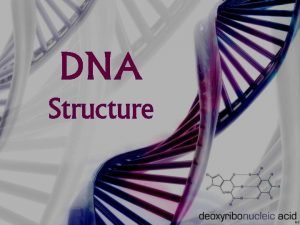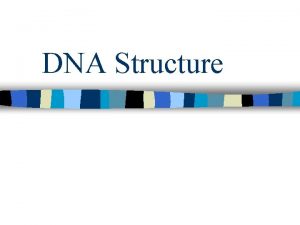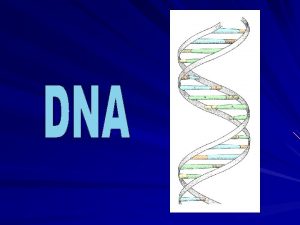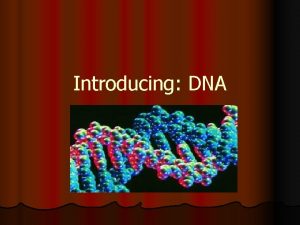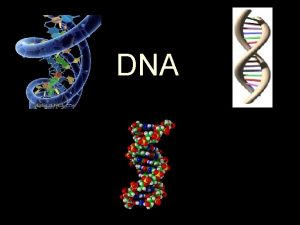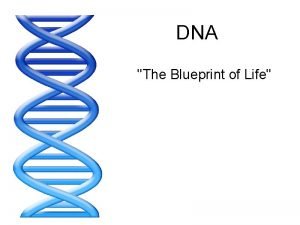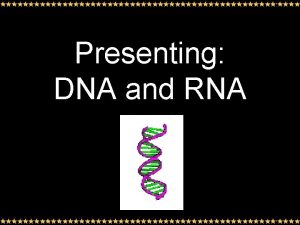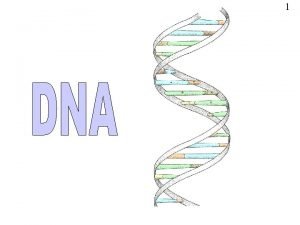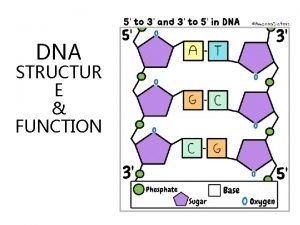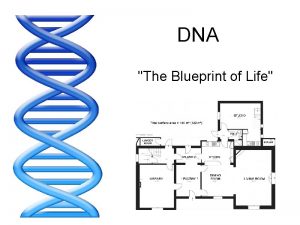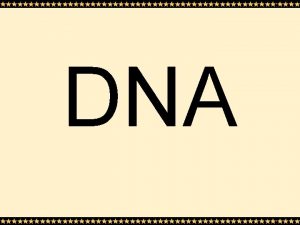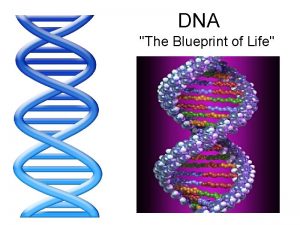DNA 11292010 What is DNA DNA stands for




















- Slides: 20

DNA! 11/29/2010

What is DNA? • DNA stands for deoxyribonucleic acid. • It holds all of our cell’s information and is located in the nucleus of the cell.

What do we already know about DNA? • It is a macromolecule known as a nucleic acid. • The monomer of a nucleic acid is a nucleotide. • What are three parts of a nucleotide? • 1. Phosphate group • 2. Sugar (deoxyribose) • 3. Nitrogen base

A Nucleotide! Draw and label this!!

Nitrogen bases • The nitrogen base can either be a purine or a pyrimidine. • How many carbon rings does each have?

Nitrogen bases in DNA • DNA has four different nitrogen bases (two purines and two pyrimidines). • The nitrogen bases are: • A is for Adenine • G is for Guanine • C is for Cytosine • T is for Thymine Adenine and Guanine are purines. Cytosine and Thymine are pyrimidines.


Nitrogen bases in DNA

What is DNA’s structure? • Two scientists, Watson and Crick, discovered the structure of DNA and published an article about it in 1953. They didn’t work alone though!

Rosalind Franklin • Rosalind Franklin was a female scientist working with DNA. • She took a x-ray crystallographic of DNA which revealed its structure in 1952. • From her photo, Watson and Crick saw that DNA was a double-helix.

Chargaff • Erwin Chargaff did research on the nitrogen bases of DNA after World War II (when was WWII over? 1945) • He conducted research on many different species and published information on the percentages of each nitrogen base found in DNA. • This helped Watson and Crick determine what bases formed hydrogen bonds with each other.

Rosalind’s x-ray crystallographic

DNA’s Ladder-like Structure • A double-helix has two strands of DNA with bonds in the middle like the rungs of a ladder. • Each nitrogen base bonds with another base to form these rungs. • A bond between two purines would be too wide. • A bond between two pyrimidines would be too narrow. • THUS, Watson and Crick determined that a purine always bonds with a pyrimidine.

What bonds with what? • Using the sizes of each base and Chargaff’s percentages they determined that…. • A bonds with T • G bonds with C

Determining the other strand So, given a sequence of DNA, we could determine what the other strand would be based on what bonds with what. What would the other strand of DNA be given the sequence: AGT GCG TAC CAT CAG AAT TTA GTC TTA AAT TCA CGC ATG

Summary • DNA is a double-stranded helix that stores our hereditary information. • It looks like a twisted ladder. The rungs of the ladder are made by hydrogen bonds between nitrogen bases and the sides of the ladder are formed by the anti -parallel sugar-phosphate backbones. • The ladder is made up by the monomers of DNA, nucleotides.

Circle the nucleotides. • Can you see how the strands are anti-parallel?



DNA Art!
 Dna center virtual appliance
Dna center virtual appliance Dna stands for deoxyribonucleic acid
Dna stands for deoxyribonucleic acid Dna stands for
Dna stands for Deoxyribose
Deoxyribose Orubbliga rättigheter
Orubbliga rättigheter Rita perspektiv
Rita perspektiv Densitet vatten
Densitet vatten Ministerstyre för och nackdelar
Ministerstyre för och nackdelar Jätte råtta
Jätte råtta Nationell inriktning för artificiell intelligens
Nationell inriktning för artificiell intelligens Tillitsbaserad ledning
Tillitsbaserad ledning Kanaans land
Kanaans land Sju för caesar
Sju för caesar Nyckelkompetenser för livslångt lärande
Nyckelkompetenser för livslångt lärande Handledning reflektionsmodellen
Handledning reflektionsmodellen Matematisk modellering eksempel
Matematisk modellering eksempel Shivaismen
Shivaismen Centrum för kunskap och säkerhet
Centrum för kunskap och säkerhet Särskild löneskatt för pensionskostnader
Särskild löneskatt för pensionskostnader Verktyg för automatisering av utbetalningar
Verktyg för automatisering av utbetalningar Expektans eller exspektans
Expektans eller exspektans


